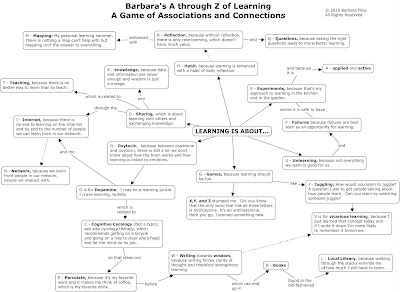In the process of preparing a short presentation on Search Engine Optimization (SEO) for my Toastmasters club (Space Speakers), I was reminded that concept maps and mind maps are not 508 compliant when they are presented in the form of an image, such as the example below. Obviously, alt text isn't going to be adequate to convey all the information presented on the map.
 |
| Click to enlarge the image. |
Here is my attempt at translating the map back into machine readable text.
Learning is about...sharing, which is about learning with others and exchanging knowledge.... and knowledge, because data and information are never enough and wisdom is just a mirage.. and it's related to teaching, because there is no better way to learn than to teach. ...sharing through the Internet, because there is no end to learning on the Internet and no end to the number of people we can learn from in our network... and network, because we learn from people in our network, people we interact with.
Learning is about... habit, because learning is enhanced with a habit of daily reflection, and reflection because without reflection there is only rote learning, which doesn't have much value... reflection enhanced with mapping, my personal learning hammer: there is nothing a map can't help with but mapping isn't the answer to everything... and questions, because asking the right questions leads to more/better learning.
Learning is about.. games because learning should be fun, like juggling. How would you learn to juggle? That's a question I ask to get people talking about how people learn. Can you learn by watching someone juggle? V is for vicarious learning because I just learned that concept today and if I write it down I'm more likely to remember it tomorrow.. and writing towards wisdom, because writing forces clarity of thought and therefore strengthens learning.... writing which can end up in books, found in the old-fashioned local library, because walking through the stacks reminds me of how much I still have to learn. X, Y and Z stumped me. Did you know that the only word that has all three letters is hydroxyzine. It's a antihistamine. Here you go, I learned something new.
Learning is about .... oxytocin, because between dopamine and oxytocin, there is still a lot we don't know about how the brain works and how learning is linked to emotions. D is for dopamine. I may be a learning junkie. I crave learning and Nutella... which is related to cognitive cycology (not a typo); see also cycology therapy, which recommends getting on a bicycle and going on a ride to clear one's head and let the mind do its job so that ideas can percolate, because it's my favorite word and it makes me think of coffee, which is my favorite drink.
And finally, learning is about... experiments, because that's my approach to learning in the kitchen and in the garden, where it's safe to have failures, because failures are best seen as an opportunity for learning, and unlearning, because not everything we learn is good for us.
Sounds like a non-sensical poem that doesn't even rhyme, doesn't it?
As a side note, this was an exercise prepared for Jane Hart's excellent "How to Become a Personal Learning Advisor" workshop.

